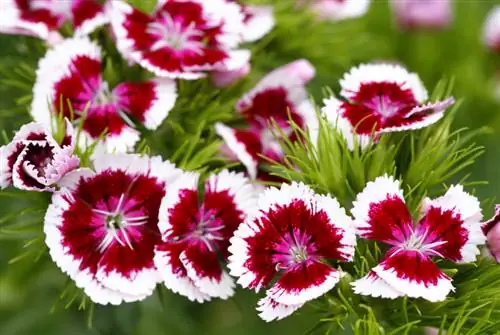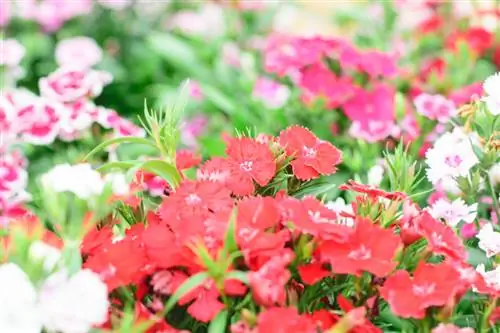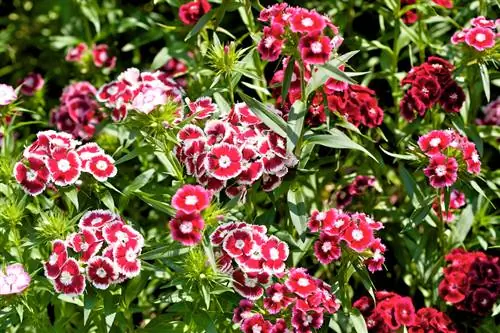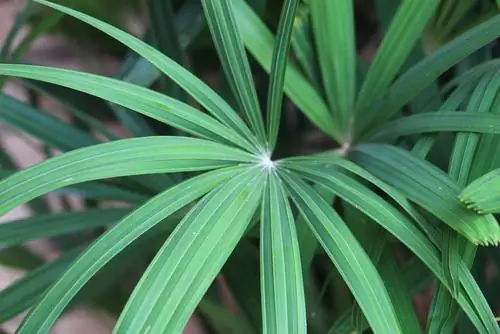- Author admin [email protected].
- Public 2023-12-16 16:46.
- Last modified 2025-01-23 11:20.
Whether in the garden or on the balcony, as a perennial in the border bed or as a ground cover: carnations are popular plants because of their wonderful flowers and their intoxicating scent. They are also ideal as cut flowers, as carnations last a surprisingly long time in the vase. However, the flowering time varies depending on the type and variety of carnation, although there are both quite early and late flowering varieties.
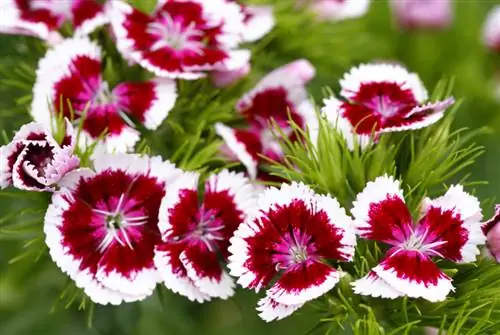
When is the flowering time of carnations?
The flowering time of carnations varies depending on the species and variety, with some varieties blooming from May to June, such as the Whitsun carnation (Dianthus gratianopolitanus), while others, such as the carnation (Dianthus caryophyllus), bloom from May to June May bloom in October. Regular care can encourage a second bloom.
Flowering times of different types of carnations
The overview below shows the different flowering times of the different types of carnations.
| Carnation type | Latin name | Flowering time |
|---|---|---|
| Heather Carnation | Dianthus deltoides | June to September |
| Whitsun carnation | Dianthus gratianopolitanus | May to June |
| Feather Carnation | Dianthus plumarius | June to July |
| Carnation | Dianthus barbatus | May to July |
| Carthusian carnation | Dianthus carthusianorum | June to September |
| Mountain Weevil | Dianthus caryophyllus | April to October |
| Chinese carnation | Dianthus chinensis | May to June |
| Carnation | Dianthus caryophyllus | May to October |
| Alpine Carnation | Dianthus alpinus | June to August |
| Siberian carnation | Dianthus amurensis | July to September |
| Sand Carnation | Dianthus arenarius | June to August |
| Fringe Carnation | Dianthus spiculiformis | May to August |
| Stemless Carnation | Dianthus subacaulis | June |
| Magnificent Carnation | Dianthus superbus | June to September |
| Stone Carnation | Dianthus sylvestris | June to September |
Encourage carnations to bloom a second time
The mat-forming species in particular should be cut back after flowering. On the one hand, this makes the overgrown areas look tidier or thicker, and on the other hand, they encourage some varieties to bloom a second time. With so-called repair pruning, you simply remove all dead shoots, although the foliage is left standing unless it has withered. You can also stimulate re-blooming by providing the cut carnations with a little liquid complete fertilizer (€18.00 on Amazon). There are many remontant varieties, especially of the Pentecost carnations and the spring carnations.
Tip
A variant of the carnation, the rare Dianthus superbus var. autumnalis, blooms particularly late.

